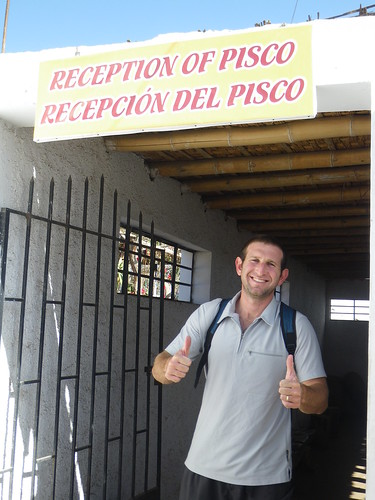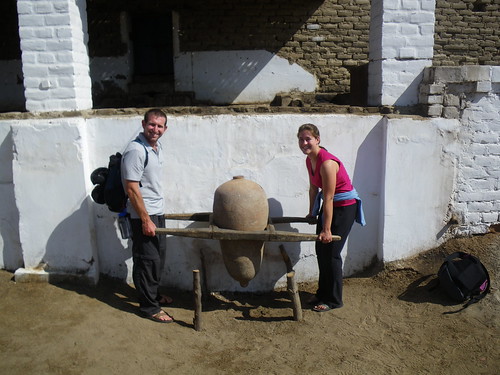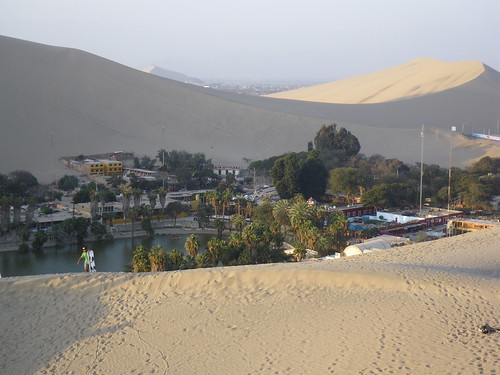 After our flight over the Nazca lines we headed to Ica, just a couple of hours up the coast from Nazca. After a quick lunch we hopped in a cab and went straight to our first Peruvian wine tour. We had hoped to do a proper tour hitting at least 3 wineries but given that we were traveling by taxi, and quite content by the end of our first, we left that total at just one.
After our flight over the Nazca lines we headed to Ica, just a couple of hours up the coast from Nazca. After a quick lunch we hopped in a cab and went straight to our first Peruvian wine tour. We had hoped to do a proper tour hitting at least 3 wineries but given that we were traveling by taxi, and quite content by the end of our first, we left that total at just one.
Peruvian wineries have something to them that no other winery we’d ever been to can boast…a pisco distillery. Pisco is, more or less, the “liquor” of Peru (and I believe a couple of other South American countries we’ve yet to get to as well) and is the base for Peru’s famous drink, the pisco sour. Having already sampled several pisco sours the chance to go to a vineyard/winery/distillery was quite inviting.
Since we arrived by taxi, we arrived alone. This wasn’t a problem. A guide was there waiting and he took  us on our own private tour. First we saw grapevines (no grapes right now, missed that by a few months) and then we walked further up the path (which was basically a grape-seed gravel) to the big grape smashing swimming pool (I should mention at this point that I might not have all the technical terms down perfectly) where the grapes are squeezed out by barefoot party goers during the grape harvest. Then the they are pressed (by a machine appropriately called the ‘press’). Since there were no grapes for us to stomp or press, Jill felt the need to place me under the press…I’m still not sure what she intended.
us on our own private tour. First we saw grapevines (no grapes right now, missed that by a few months) and then we walked further up the path (which was basically a grape-seed gravel) to the big grape smashing swimming pool (I should mention at this point that I might not have all the technical terms down perfectly) where the grapes are squeezed out by barefoot party goers during the grape harvest. Then the they are pressed (by a machine appropriately called the ‘press’). Since there were no grapes for us to stomp or press, Jill felt the need to place me under the press…I’m still not sure what she intended.
This is where the wine and Pisco process divide. After the press we moved to where the pisco and the wine (both just grape juice at this  point) are fermented. Here in Peru rather than talking about the benefits of oak versus steel barrels we checked out the traditional ceramic casks used in the Pisco process and compared them to the cement casks primarily used today. The wine of course is still fermented in wooden casks, but considering Pisco is the main attraction the guide left the wine process behind and just told us about Pisco.
point) are fermented. Here in Peru rather than talking about the benefits of oak versus steel barrels we checked out the traditional ceramic casks used in the Pisco process and compared them to the cement casks primarily used today. The wine of course is still fermented in wooden casks, but considering Pisco is the main attraction the guide left the wine process behind and just told us about Pisco.
Next up is the distillery where 1600L of fermented grape juice is poured into a giant ceramic barrel. Under the barrel was a big pit where a giant wood fire could be stoked, ultimately boiling the grape juice inside. As the 1600L are boiled the juice is turned to steam, leaving behind most of its mass to be reused as fertilizer. As the juice boils, the vapors escape the barrel through a pipe at the top which pipes the gas under a pool to condense before being  poured out as pisco.
poured out as pisco.
Pisco it turns out comes out of the distillation process as a man. The first 10L or so of Pisco that flow from the pipes are the head, which is too high in alcohol content to be consumed, but is perfect for sterilizing equipment. The next 400L is the body and id only portion of the original 1600L that will be consumed. The final 60L or so are the tail, which like the head is not consumed.
An consume we did. We tried the Torontel, made from aromatic grapes, the Quebranta, made from non-aromatic grapes, and the Acholado, the mix of the first two from which pisco sour is made. We also tried a version mixed with milk which is basically a version of Bailey’s made with pisco as well as several of their wines. By the time we were done we were quite pleased with tasting and then he pulled  out some chocolates. Needless to say there was no need of continuing to another vineyard.
out some chocolates. Needless to say there was no need of continuing to another vineyard.
Next up was a trip to the Huacachina oasis just outside of Ica’s city limits. This is the main gringo hangout of the area on account of the oasis itself (which was a brown lake, dirty and completely uninviting) and the rather impressive sand dunes. Within one hour of our arrival we’d changed into shorts and rented a pair of sandboards (cost $3 each rather than the $12 dune buggy/sandboarding tour) and were hiking up and boarding down dunes until the sun set over the desert. Luckily the soft sand was more forgiving the volcanic rock we boarded down the last time. Can´t say we made much improvement though!
Hey guys – you on Twitter? If so, let me know your handle. Connecting your Twitter to the blog is a great promotional tool. Hard to build a Twitter following from the road, I realize, but I’d help with retweets of posts. 🙂
Now that day sounds like fun! And Jill, I just love the color of your top on you! 🙂
sounds like a great time you guys. This Pisco sounds like it might be just what the doctor didn’t order, once I’m given the go ahead. Looking forward to see you both this winter. Thank you so much for the call. It was such a great surprise!
Love ya,
Uncle Dan